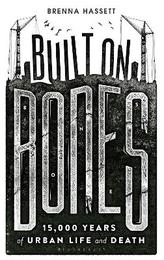
|
Built on Bones: 15,000 Years of Urban Life and Death
Paperback / softback
Main Details
| Title |
Built on Bones: 15,000 Years of Urban Life and Death
|
| Authors and Contributors |
By (author) Brenna Hassett
|
| Physical Properties |
| Format:Paperback / softback | | Pages:320 | | Dimensions(mm): Height 198,Width 129 |
|
| Category/Genre | Archaeology
Popular science
Human biology |
|---|
| ISBN/Barcode |
9781472922960
|
| Classifications | Dewey:307.7609 |
|---|
| Audience | |
|---|
| Illustrations |
8pp colour plate section
|
|
Publishing Details |
| Publisher |
Bloomsbury Publishing PLC
|
| Imprint |
Bloomsbury Sigma
|
| Publication Date |
11 January 2018 |
| Publication Country |
United Kingdom
|
Description
Imagine you are a hunter-gatherer some 12,000 years ago. You've got a choice - carry on foraging, or plant a few seeds and move to one of those new-fangled settlements down the valley. What you won't know is that city life is short, brutish, and riddled with dozens of new diseases, your children will be shorter and sicklier than you are, they'll be plagued with gum disease, and stand a decent chance of a violent death at the point of a spear. Why would anyone choose this? But choose they did. Why? This is one of the many intriguing questions tackled by Brenna Hassett in The Urban Ape. Based on research on skeletal remains from around the world, this book explores the 12,000-year history of humanity's experiment with the metropolis, and looks at why our ancestors chose city life, and by and large have stuck to it. It explains the diseases, the deaths and the many other misadventures that we have unwittingly unleashed upon ourselves throughout the urban past, and as the world becomes increasingly urbanised, what we can look forward to in the future. The Urban Ape offers an accessible insight into a critical but relatively unheralded aspect of the human story: our recent evolution. It tells the story of shifts in human longevity, growth and health that have occurred as we transitioned from a mobile to a largely settled species. Beginning with the very earliest experiments in settling down, the narrative moves slowly forward in time, with each chapter discussing a new element of humanity's great urban experiment. In the first section of the book, the major differences between hunter-gatherers and sedentary farmers are considered in chapters that cover the drop in life-expectancy associated with the Neolithic revolution, our changing relationship with animals and their diseases, and critical changes in our health that came with farming. In the second, the effects of true urban living are covered, from some of the earliest cities; the effects of overcrowding and population density in terms of disease and interpersonal violence are examined in remains excavated from Peru to Spain. In the third section, the diseases of the great empires are examined, and the effects of war, plague and social inequality on human lives, and in its final section we come to the great interplay of social inequalities, diseases, and population that has seen some diseases disappear (such as leprosy), while others like tuberculosis scar modern cities to this day. The book concludes with a review of the many ways in which cities have affected our increasingly urban physical lives, and asks why city life can be deemed so successful, no matter how many individuals fall foul of numerous urban blights.
Author Biography
Brenna Hassett is an archaeologist who specializes in using clues from the human skeleton to understand how people lived and died in the past. Her research focuses on the evidence of health and growth locked into teeth, and she uses dental anthropological techniques to investigate how children grew (or didn't) across the world and across time. She has dug poor Roman-period burials near the Giza pyramids, surveyed every last inch of a remote Greek island famous for the Antikythera mechanism (with a goat-to-human ratio of 350:1), looked intently for slag at the foot of a Buddhist monastery in northern Thailand, accidentally crumbled an 8,000 year old mud brick wall at the famous central Anatolian site of Catalhoeyuk in Turkey, and drunk whiskey watching twilight fall over Cappadocia at the beautiful nearby site of Asikli Hoeyuk. Brenna is one-quarter of the TrowelBlazers project, an outreach, advocacy and academic effort to celebrate women's contributions to the trowel-wielding arts. Originally from the United States, she completed her Ph.D at University College, London, and has been based at London's Natural History Museum since 2012. @brennawalks / trowelblazers.com
ReviewsBuilt on Bones is entertaining, colloquial and has a fine line in funny footnotes. * The Times * An upbeat, wisecracking attempt to trace the development of cities through thousands of years of human disease, violence and misery ... Amusing footnotes interrupt serious arguments, while pop culture references jostle with sobering research. * Guardian * .. Hassett shines a fascinating light on the work of archaeology in explaining the way we live now through analysis of the lives and deaths of our ancestors. * Daily Mail * Fascinating subject matter ... a fun, addictive read. * Reader's Digest * Ms. Hassett [...] has gifts of scholarship and wordsmithery [...] she addresses one of the most absorbing problems in the history of the last 14,000 years. * Wall Street Journal * An amusing and scholarly book. * The Times, Saturday Review * This book explores how our journey from hunter-gatherers to urban dwellers has impacted our state of health. Using clues recovered from archaeological sites and ancient skeletal remains, it carefully highlights some of the unpleasant consequences of urbanisation. -- Dr Daniel Antoine, Curator of Physical Anthropology, The British Museum
|